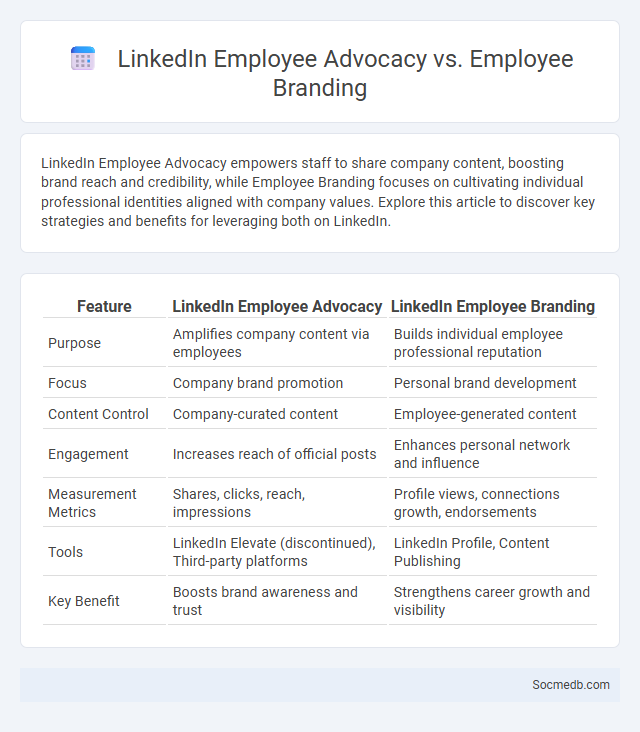
Photo illustration: LinkedIn Employee Advocacy vs Employee Branding
LinkedIn Employee Advocacy empowers staff to share company content, boosting brand reach and credibility, while Employee Branding focuses on cultivating individual professional identities aligned with company values. Explore this article to discover key strategies and benefits for leveraging both on LinkedIn.
Table of Comparison
| Feature | LinkedIn Employee Advocacy | LinkedIn Employee Branding |
|---|---|---|
| Purpose | Amplifies company content via employees | Builds individual employee professional reputation |
| Focus | Company brand promotion | Personal brand development |
| Content Control | Company-curated content | Employee-generated content |
| Engagement | Increases reach of official posts | Enhances personal network and influence |
| Measurement Metrics | Shares, clicks, reach, impressions | Profile views, connections growth, endorsements |
| Tools | LinkedIn Elevate (discontinued), Third-party platforms | LinkedIn Profile, Content Publishing |
| Key Benefit | Boosts brand awareness and trust | Strengthens career growth and visibility |
Understanding LinkedIn Employee Advocacy
LinkedIn employee advocacy enhances brand visibility by empowering employees to share company content with their professional networks, increasing reach and credibility. Engaged employees acting as brand ambassadors boost trust and attract potential clients or talent through authentic interactions. Leveraging LinkedIn's analytics tools helps measure the impact of advocacy efforts on engagement, lead generation, and overall business growth.
Defining Employee Branding in the Digital Era
Employee branding in the digital era involves employees actively shaping and projecting an organization's identity through their social media presence. This practice enhances brand authenticity by leveraging personal networks and real-time interactions, increasing trust and engagement among consumers. Integrating employee stories and values on platforms like LinkedIn, Instagram, and Twitter strengthens corporate reputation and drives recruitment efforts.
Employee Advocacy Beyond LinkedIn
Employee advocacy extends beyond LinkedIn to platforms like Twitter, Instagram, and TikTok, where authentic employee voices drive brand engagement and trust. Companies leveraging multi-platform advocacy experience increased reach, higher content engagement, and improved recruitment outcomes by showcasing diverse employee experiences. Strategic empowerment of employees to share expertise and company culture fosters organic growth and strengthens corporate reputation across social networks.
Key Differences: LinkedIn Advocacy vs Employee Branding
LinkedIn Advocacy centers on employees actively promoting their company's content to expand reach and credibility, while Employee Branding focuses on shaping and showcasing the individual identities of employees to enhance the company's overall image. Your team's LinkedIn Advocacy efforts drive awareness by sharing strategic posts, whereas Employee Branding emphasizes authentic personal storytelling and expertise to build trust and engagement. Both approaches leverage social media but differ in purpose: Advocacy amplifies corporate messaging, whereas Employee Branding nurtures individual influence aligned with organizational values.
Benefits of LinkedIn Employee Advocacy Programs
LinkedIn employee advocacy programs significantly enhance brand visibility by leveraging employees' professional networks, increasing organic reach and engagement. These programs foster trust and credibility as authentic employee voices share company content, resulting in higher quality leads and improved recruitment efforts. Data shows businesses with active LinkedIn advocacy see a 58% increase in brand awareness and a 20% boost in sales opportunities.
Core Elements of Effective Employee Branding
Core elements of effective employee branding include authentic storytelling that highlights your workforce's unique skills and values, consistent visual identity that aligns with your company's mission, and active engagement through social media platforms to amplify employee voices. Leveraging employee advocacy programs encourages genuine content sharing, enhancing trust and credibility among target audiences. Monitoring and analyzing social media metrics help refine strategies and ensure your brand messaging resonates with both current and potential employees.
Measuring Success: Metrics for Advocacy and Branding
Tracking key performance indicators such as engagement rates, reach, and sentiment analysis provides critical insights into the effectiveness of your social media advocacy and branding efforts. Monitoring follower growth and conversion metrics helps determine how well your content resonates with the target audience and drives desired actions. You can optimize strategies by analyzing click-through rates and share statistics to enhance visibility and influence across platforms.
Challenges and Solutions in Employee Advocacy Efforts
Employee advocacy on social media faces challenges such as inconsistent messaging, lack of employee engagement, and concerns over privacy and compliance. Implementing comprehensive training programs, clear social media guidelines, and incentivizing participation can enhance consistency and enthusiasm. Utilizing analytics tools to monitor advocacy impact helps refine strategies and ensures alignment with brand objectives.
Integrating LinkedIn Advocacy and Branding Strategies
Integrating LinkedIn advocacy and branding strategies enhances your professional presence by leveraging employee networks to amplify authentic brand messaging. Utilizing LinkedIn's advocacy tools helps you engage your audience through personalized content, boosting brand credibility and expanding reach. Strategic alignment of employee advocacy with brand values ensures consistent messaging that drives trust and business growth.
Future Trends in Employee Advocacy and Branding
Employee advocacy programs will increasingly leverage AI-driven analytics to identify and amplify authentic employee voices, boosting brand credibility and reach. Social media platforms are evolving to support immersive content like AR and VR, enabling employees to share dynamic stories that engage audiences more deeply. By integrating these innovations, your company can transform its workforce into powerful brand ambassadors, enhancing recruitment and customer loyalty.
 socmedb.com
socmedb.com